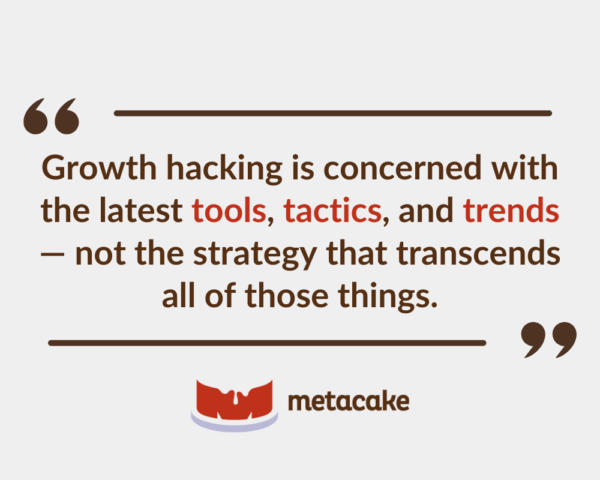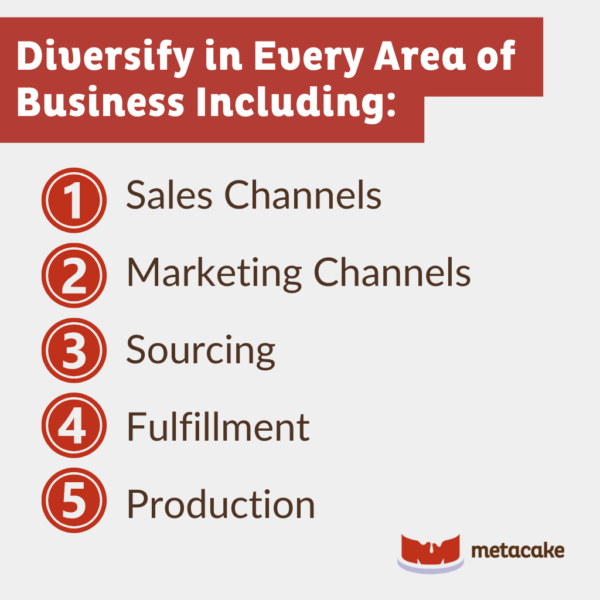Have you noticed that our culture seems to be all about short-cutting our way to success? We’re addicted to immediate gratification, and to experience that, things need to move fast. Whether it’s our health, wealth, daily routines, or business, the more “smart” shortcuts we can find, the better. Right?
In ecommerce, we refer to these shortcuts as “growth hacks,” and they aren’t all bad. In fact, some entrepreneurs are undeniably successful thanks to shortcuts.
However, more often than not, those wins are not long-lasting. Growing dependent on these “hacks” can lead to issues with your business down the road.
If you study how the most successful ecommerce businesses became great, you’ll realize that the fast growth these hacks promise isn’t actually a long-term solution. You don’t need fast growth; you need healthy growth to be set up for long-term success.
In this post, we’ll explain the difference between growth hacking and growth strategy for ecommerce as well as why a growth strategy is better for building a stable, secure business and provides a much higher likelihood of winning.
We’ll also dig into how to grow an ecommerce business by implementing a healthy growth strategy in your organization.
What Is “Growth Hacking”?
Over the last decade or so, it’s become easier than ever to advertise, sell, and shop online. All of this has presented remarkable opportunities, but it’s also paved the way for some faulty business habits and philosophies as well. Many have adopted growth hacking as a legitimate business strategy when, in reality, it can hurt your business.
Our definition of “growth hacking” is constantly searching for quick wins, easy tricks, and silver bullets that can be used to achieve success, as opposed to investing in a long-term strategy based on long-standing truths. Growth hacking is concerned with the latest tools, tactics, and trends — not the strategy that transcends all of those things.
This does not mean that growth hacking tactics are entirely bad, but it does mean that they are incomplete. We see so many businesses get caught in the trap of growth hacking, to the point where it is all they do.
It makes sense why this happens so easily. If you’re in the industry, you’re probably bombarded with marketing that promises one trick to make your business explode overnight. In reality, that’s almost never the case.

What Is a Healthy Growth Strategy?
A healthy growth strategy for ecommerce is based on the fundamental truths of business combined with your brand’s unique purpose. It uses those two elements to design a strategic plan rooted in experience to achieve a defined goal.
This plan is diversified (not overly reliant on one source of revenue), and the experience behind it allows you to plan for problems before they arise. It is forward-facing and aggressive but focuses on more than trendy tactics and quick wins.
The advantage of a healthy growth strategy is that it promotes a business that stays focused on the long haul rather than changing direction from week to week. A healthy growth strategy allows for more traction and a much higher likelihood of success with less volatility and burnout.
You may have to sacrifice a few quick wins in order to stay focused, but your time is much better spent laying a strong foundation than taking a few steps and then backtracking in favor of what the latest tool or guru says.
But what about staying “relevant”?
Keeping up with what’s “working” today is important, absolutely. That’s why a healthy growth strategy requires an experienced team that has the discipline to stick to a plan while also understanding all the tricks. The right team can develop a solid growth plan and not be distracted by unnecessary silver bullets.
The Consequences of Growth Hacking
So, what happens if you abandon a healthy growth strategy and chase growth hacking tactics instead?
By relying on growth hacks, you and your team will essentially be on a rollercoaster every day. The internet changes constantly, and that means there could be new theories on the best way to win every week. It may be fun to always chase the next win, but it could also be a disaster.
As your business grows, you will also see “gotchas” arise. A larger business is a more complex business, and initiatives will trample each other if there is no disciplined plan and coordination between them.
All in all, growth hacks could bring colossal growth, but it could also bring colossal failure; it’s a gamble.
How to Grow an Ecommerce Business
A successful ecommerce business starts with a healthy growth strategy that comes from experience, intentional strategy, and careful planning. Here are five tips you can use to help implement this kind of strategy in your organization.
1. Determine Your Company’s Purpose and Objectives
We talk about purpose a lot and have a variety of articles and videos dedicated to helping you identify your brand’s purpose. Your company’s purpose and objectives are more than just revenue, profit, customers, or anything quantifiable — they’re important indicators of success that should be tracked.
Your purpose goes back to the reason your brand exists, which includes the pain points your products solve and the motivating forces behind any action your business takes. These can become guiding principles that keep you moving and steer you away from wrong decisions. The bigger your purpose, the deeper your motivation will be, and that means you are more likely to connect with customers as well as survive in any environment.
2. Think Holistically
Everything in your business is connected, including sales channels, marketing channels, and the actions you take in each. Thinking about each part of your business independently, such as wholesale vs. your online store, simply doesn’t work.
Nothing can be managed in isolation because each piece affects another. This is why you need experienced leaders who understand the bigger picture to guide holistic decision-making.
This is especially true with marketing channels. As much as your favorite online growth hacker may tell you about all of the revenue made by one marketing platform, the truth is that all of your channels play into sales. You can’t turn off everything and isolate the one platform that’s winning because they all support each other.
3. Build Your Brand Equity
There is a real business case for investing in brand equity, and we’ll give you two reasons why.
First, your brand is your biggest competitive advantage. It’s the only thing completely unique to you. Your product, business model, and marketing can all be ripped off, but your DNA and the connection you have with customers can’t.
Second, investing in your brand equity builds a brand voice. If your brand voice has true respect and authority in the marketplace, that’s a highly valuable asset.
These concepts are nothing new, yet so many businesses today never intentionally invest in their brand equity. Instead, they focus solely on ROI and attribution without giving proper consideration to brand investment. Building brand equity is a concept you need to embrace if you’re going to grow consistently over the long term.
4. Diversify Everything
Stock portfolio managers and financial advisors have been doing this forever. But unfortunately, many businesses fall apart because they fail to diversify their sales channels and marketing channels.
Diversification is essential to survive in any business climate, good times or bad. If your eggs are in one basket and that basket is extremely successful, it’s tempting to keep throwing all of your money in that basket. But what happens when that basket is taken away? You’re toast.
The challenge is this: In order to diversify your business, you must choose to step out of the reactionary mindset (diversifying only when you’re forced to). Things may be successful today, but that could change at any time. So many companies get caught up in what is working now and never consider the repercussions of it being taken away.
A very tangible example of this is Facebook and Instagram advertising. A few short years ago, it was normal for great brands to see a 5x return on their social media ad spend. But then, increased competition on the channel along with data privacy changes changed things dramatically. The brands that relied heavily on Facebook as their main source of traffic and revenue ended up scrambling and dealing with the consequences.
This is why it’s so important to invest in new areas of your business without expecting an immediate return. Start an affiliate or wholesale channel, for instance, or invest in email marketing.
This should be done when your business is doing well, so you actually have the funds to build these additional channels. You should diversify in every area of business, including sales channels, marketing channels, sourcing, fulfillment, production, etc.

5. Create Fans, Not Customers
A brand fan is much more valuable than a customer. We often put so much attention on acquiring the initial sale that we forget about the lifetime value of the customer. Keeping an existing customer (nurturing that relationship so they come back to buy again and again) is much more cost-effective than constantly chasing new customers.
Plus, when you invest in lifelong brand fans, they become marketers for you. They will shout your name from the rooftops and eventually become a valuable audience that brings herds of new business to your door.
Here’s the catch, though: You must have a strategy and business model for supporting the effort of creating fans while still profiting. You don’t want to lose money attempting to create fans.
You can actually plan for fan creation by having a great product, a compelling offer, stand-out customer service, and eliminating risk for the customer as much as possible. All of this should exist inside your business model, and you need to make sure your product margins provide enough funds to support these strategies.
For example, if you offer a lifetime guarantee, make sure your margins allow you to replace products and still generate a healthy profit.
Ready to Plan Your Healthy Growth Strategy?
Planning for long-term, healthy growth is the only reliable way to build your business, no matter what. When you do so, your business will have the foundation it needs to survive any crisis, whether there is a disruption in the marketing industry (such as your Facebook account getting shut down) or a disruption in the world (economic or other).
If you’re looking for experienced guidance on developing a strategy to grow your ecommerce business, we’d love to help. Click below to contact us!
